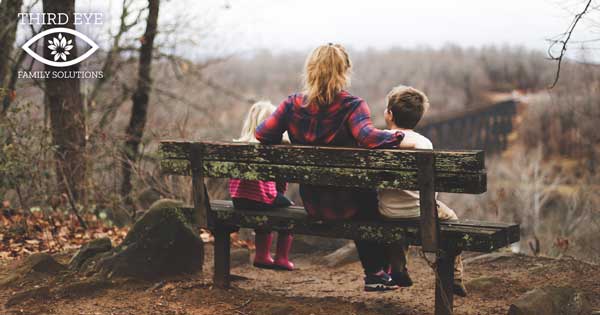We often use the term “Connection Based” to describe parenting, but many people ask, “What exactly does that MEAN?” It’s a hard term to define simply, but examples help!
In essence, connection based parenting means that each time you are interacting with your children, you deal with connection first. That means connection before play, connection before communication, and especially connection before discipline. It’s easy to become distracted and be ‘half there’ with our children.
Most parents will have times when we pretend to drink the imaginary cup of milk our three year old handed us, when we are actually thinking about the errands we need to run. However, we have also all seen the difference between those moments and the ones in which we connect and fully engage. Our children are happier, and seem to need less of our attention when the attention they get comes from connection.
In discipline especially, connection is critical. Connection is important to our children’s mental health – they need that physical warmth, the eye contact, and the real listening that takes place in connection. Taking the few seconds to get down on our child’s level, hold their hand or hug them, and establish a baseline of love makes all the difference when we need to teach. Hand in Hand Parenting has a lovely video that talks about the reasons that connection is so important. Looking at some examples can be helpful in understanding how to use connection in your parenting when challenges come up.
Example One of Connection Based Parenting: Toddlers
To a small child, the adults in the world can be a source of love or a source of fear. We are bigger than they are, we can be louder, and we can easily move them around when needed. When toddlers have tantrums it is often the adult response to move them to a different space (such as a crib or another room). We tell them to stop crying, or to stop hitting or throwing things. When we are connecting, we respond differently.
To connect with a child, first, get onto the same level as your child. If they are on the floor, sit or lie next to them. Using calm tones, we can say things such as, “You are really upset right now,” or “Wow, you must really be angry about X.” If appropriate, you can put your hand on the child’s arm or back. There are times that we need to hold the child to keep them safe, but it is best to only do this if they are willing or it is necessary for safety.
As we make this physical and emotional connection, even young toddlers will begin to calm and can respond to any redirection you need to give.
Example Two of Connection Based Parenting: Young Children
Up until around age 9-10, children still need the same kinds of connection. They need the physical touch, they need us to be on their level, and they need to hear calm words of reassurance.
Connecting with a young child who is angry or upset doesn’t look very different – we want to be physically close, on their level, and touching if appropriate – though our words may change. We still want to name feelings with them because children are still learning how to identify their emotional experience.
We may say, “Are you angry about X or do you feel a different way?” or “It seems like you are sad about what happened, are you?” These more open-ended questions give children a space to express how they feel by either agreeing with your assessment or looking for different words. When they know that you are there and safe they will begin to talk about what is happening.
Example Three of Connection Based Parenting: Older Children and Teens
Connecting with our older children is trickier. Getting on their level is not usually needed, especially when they grow taller than us! They still need the feelings of safety that closeness offers, especially when dealing with stress or upsetting situations. Sitting near your child is often close enough. Many times, our silence is more helpful than any words we can say, though offering up a short, “I hear you are upset, feel free to talk to me when you are ready,” can be helpful.
Some teens want physical touch while others don’t, you know your own children well enough to know what is best on that account. Dr. Jen’s teens will often put their head on her shoulder when they need connection – easy to do when mom is 5’5” and the kids are 6’!
You might be thinking, “This is all so simple and easy!” In truth, it really is! The tricky part is that we must deal with our own emotions before any connection is possible. If you are angry that your toddler spilled the paint or hit her brother, no amount of physical closeness is going to convey connection.
If you feel disappointed in your teen for making a risky choice, saying “I’m here when you are ready to talk,” isn’t going to make any difference. The best way to practice this kind of connection is to use it when there is no conflict present. Get on the floor with your 2-year-old and try “sports-casting” or narrating their play. Tell your 8-year-old “Wow, seems you are in a really great mood today, are you?” Then really listen when they respond. Talk to your teen about what’s happening when they seem calm and relaxed.
It’s Ok if It Looks Different for Each Child
Connection can look different for many parents, and each child responds to different ways of connection differently. The core message is that connection is essential for the human brain to feel safe, and when we feel safe we can begin to solve problems and address conflict.
Do you have a favorite way to connect with your children? We would love to hear about it!
At Third Eye Family Solutions, it is our goal to empower parents and families to have the best relationship possible, using healthy tools to facilitate communication, love, and connection.
You can find more resources on positive parenting here on our blog. We also have a few different articles about Time-Ins, Consequences, and More. We also offer a variety of services to help children, and parents alike, particularly when dealing with challenging circumstances and unique experiences. If you are interested in learning more about our services we offer a FREE consultation.


Recent Comments